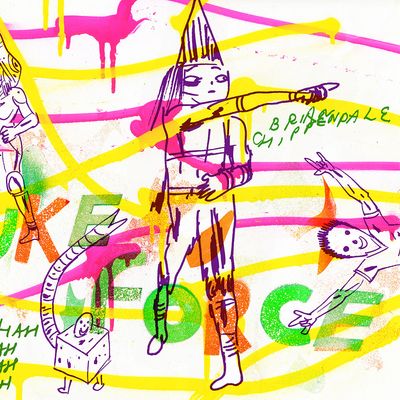
If thereÔÇÖs a single adjective that unites Brian ChippendaleÔÇÖs work as drummer and vocalist for seminal noise-rock band Lightning Bolt and his work as the creator of avant-garde comics, itÔÇÖs this one: raw. Everything he does has an immediacy and a grittiness that cuts past your defenses and makes you feel anger, sympathy, fear, or joy.
That raw quality is very much on display in his new collection of comic strips, Puke Force. TheyÔÇÖre all sized more or less like a Sunday-newspaper comic strip (think Calvin & Hobbes), but their content is as surreal as it is thrilling: There are bombings, invasions of sentient YouTube comments, travails of an incompetent superhero team, and much more. All the while, the work is grounded in the hopes and fears of a bizarre cast of characters, including a pantsless man named A.W. Dude and a one-armed robot named Gregus. ItÔÇÖs political, itÔÇÖs satirical, and itÔÇÖs endlessly surprising.
Chippendale will be appearing at BrooklynÔÇÖs Desert Island Comics on Friday night, and┬áwe caught up with him to talk about the overlaps between his music and his comics, his love of Lost, what makes him scared, and his bandÔÇÖs odyssey traveling through France in the immediate aftermath of last yearÔÇÖs Paris bombings.
Were you a comics geek as a kid?
Oh my God, yeah, super comic geek. I would get the comics in the mail, they would come in this brown-paper slipcase thing, crunched in your mailbox. I was hooked. Except for a very poor, poor period through college, IÔÇÖve been getting pretty much mainstream stuff ever since. IÔÇÖm still hooked.
Your comics are pretty avant-garde, but what mainstream stuff do you still read?
Kind of the same stuff. I donÔÇÖt know what that says about me. I mean, X-Men, Daredevil. ThereÔÇÖs this Image Comics revolution going on, so IÔÇÖm getting a lot of that stuff, too. Greg Rucka has this comic called Lazarus, which I think is really great, with this artist Michael Lark. I think thatÔÇÖs awesome. IÔÇÖve been traveling a lot the last couple of months, or not home, so IÔÇÖm so backed up. I just want to read. I get way too much stuff.
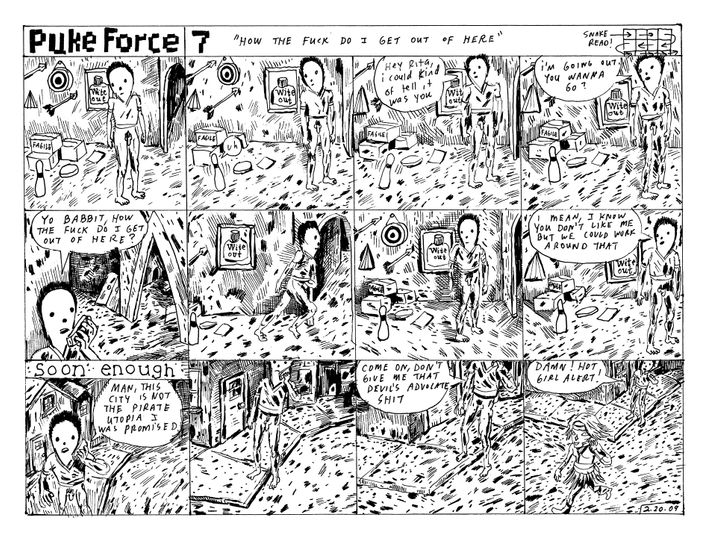
This is the struggle for any mainstream comics fan. ItÔÇÖs a volume industry. ThereÔÇÖs too much goddamn stuff to buy and read. How the hell are you supposed to get through everything?
You just canÔÇÖt! ItÔÇÖs funny, when I was a kid, the idea of a series coming out once every two months would kill me. I would be like, ÔÇ£No! I want that book every month!ÔÇØ Now IÔÇÖm almost like, ÔÇ£Please donÔÇÖt put it out every month, thereÔÇÖs just too many of them.ÔÇØ
When and how did you get into more underground, weird comics?
The funny thing is, I never really did. I think what I make is really a combination of mainstream stuff and then newspaper funnies. I never actually got that into underground comics. I skipped around it. Even to this day, IÔÇÖve got some Daniel Clowes, IÔÇÖve got some mainstays of underground comics, but IÔÇÖm not an avid collector. I always pegged it as, I donÔÇÖt know, these comics about people sitting around being depressed and drinking coffee or something. Which is just the worst, there are so many different things. I think I saw a bunch of underground comics at a certain time and I was like, ÔÇ£Oh my God, this is nerds making comics for nerds.ÔÇØ I couldnÔÇÖt handle it. Come on, man, I want to see dudes fighting! I was into comics for the adventure and the weirdness of it!
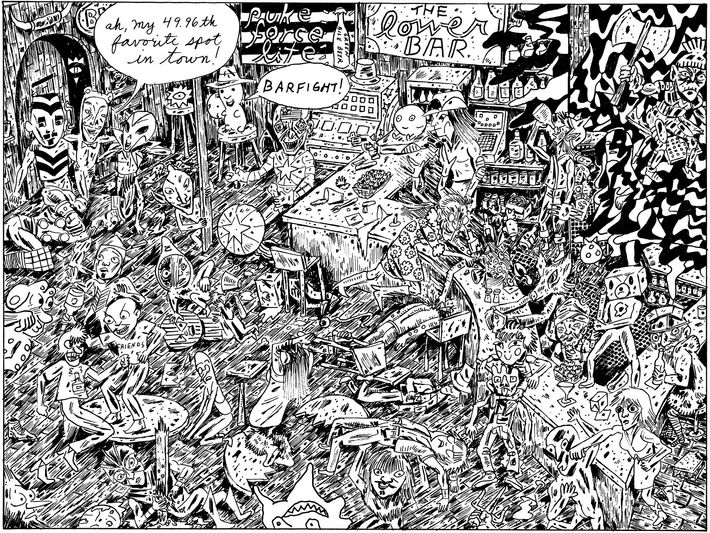
When and why did you start making comics?
My first period of really drawing a lot of comics was seventh and eighth grade, I think. Me and a couple friends each had some form of a ninja comic. Mine was just called Ninja, and my friend had Ninja Salamander. Then we had superhero comics ÔÇö he had Super Salamander, of course, and then I had a bunch of superhero comics. I guess he was really into salamanders. I think I was 10 years old, and I was drawing these ninja comics. I did a book called Ninja that was reprinting those original ninja comics and then picking up 20 years later to continue the adventures of this ninja. Then I fell out of it all through college because I was in art school, and I donÔÇÖt know ÔÇö comics had become so cool, but the art-school experience, for me, was not based in that kind of thing. It was more physical art, and bigger and grander and more reckless than doing drawings on a page, in a way.
Speaking of which: You do more gallery-style visual art, too. What can comics do that other mediums canÔÇÖt?
The idea is that you have these sequential frames, so theyÔÇÖre really good for storytelling. You can follow a conversation or follow a movement through a page. TheyÔÇÖre built to tell stories. For me, for a piece of fine art, if youÔÇÖre looking at a flat surface, you can also tell stories, but I think they can be built to do other things, like to play with the medium, or to show one moment instead of a drawn-out amount of moments. Comics are good for narratives, and fine art is good for a moment.
When and why did you start doing Puke Force?
It was 2009 or 2010. I had these characters that had been in this Ninja book, and I missed them, so I was like, ÔÇ£IÔÇÖll just start doing this really fast, like a Sunday strip or a comic-book newspaper thing.ÔÇØ It was eight panels: four across and four up. It was these characters from Ninja doing stupid stuff. Try to get a punch line done on a one-page thing. I did it on and off, and then at some point started getting really into it and getting carried away.
At what point did you decide, ÔÇ£This is a project, IÔÇÖm building a world here, and thereÔÇÖs going to be an overall narrativeÔÇØ?
The way Puke Force started out would be seven episodes with either eight or 12 panels, and then, every eight pages, there would be a splash page. It was supposed to have this rhythm for awhile. Story, story, story, and then boom, on the eighth page, thereÔÇÖd be some big thing. It was a full-page thing, and I realized I liked this rhythm, and then maybe at that point I was like, ÔÇ£Okay, I have to keep going. This just stepped up a level. This is a real thing now, itÔÇÖs not just jokes.ÔÇØ ItÔÇÖs almost like everything I do starts out like a joke, and then if I do it for a couple days, IÔÇÖm just, ÔÇ£This is kind of cool. I should keep going.ÔÇØ It doesnÔÇÖt take me long to get taken in by my own bad ideas.
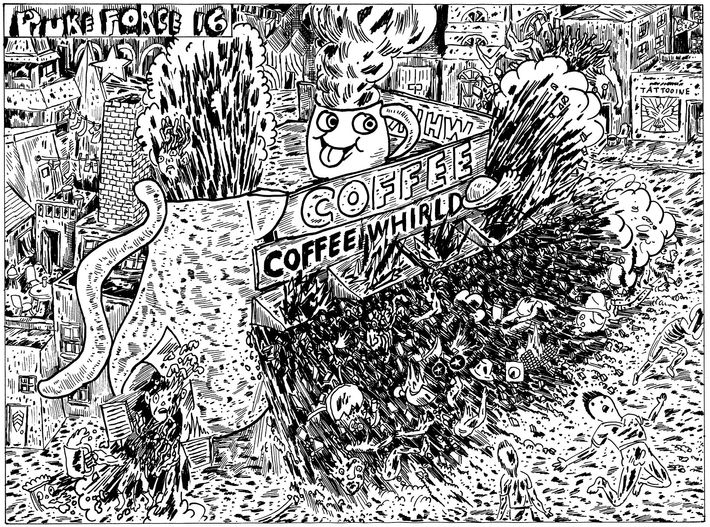
When you tell people about Puke Force, what is your summary of it? IÔÇÖm dreading having to summarize it in the article, itÔÇÖs so hard to encapsulate.
I have this city. ItÔÇÖs called Grave City, and Puke Force is really a snapshot of whatÔÇÖs happening in this city. The overarching good-guy/bad-guy story, which there is one, is that thereÔÇÖs these teams of weirdos that live in their secret headquarters, and theyÔÇÖre kinda crime-fighters. All the evil comments on YouTube or whatever website, all those evil comments, are personified, too. TheyÔÇÖre this weird black pudding that sucked people in and made them say horrible things and do horrible things. In the background thereÔÇÖs this evil digital community versus a maybe good community.
ItÔÇÖs a lot of satire, it dips into politics in various ways. ItÔÇÖs a ramble. ItÔÇÖs if you just took a camera and walked through the city, and you managed to hit peaks of activity over the course of a few weeks. ThatÔÇÖs kind of what it is. ItÔÇÖs a bit of a portrait of a place and a time thatÔÇÖs satirical and kind of violent. And funny, really fucking funny. [Laughs.]
ThereÔÇÖs kind of a Lost vibe throughout the book. YouÔÇÖll have these major events, like a caf├® bombing or the creation of a surveillance system, and youÔÇÖll dig into the different back- and side-stories of the characters involved. How much of an influence was that show?
At some point I watched all of Lost. Maybe I even watched all of Lost twice over the course of making Puke Force. IÔÇÖm actually a huge Lost fan. Except for the final season, like many people. I loved that show, for the most part. It was definitely an influence. I donÔÇÖt know if it was specifically an influence in that moment [of the caf├® bombing]. Somehow that came to me. ThereÔÇÖs a few runs of episodes in Puke Force where I really hit a really good pace. There was a lot of momentum, and the ideas were really flowing.
How important is doodling to you?
I draw constantly. Like this morning, IÔÇÖve just been drawing for the last two hours. I have piles, mountains of pages of stuff, drawings. ItÔÇÖs where everything comes from. ItÔÇÖs where character designs, itÔÇÖs where narrative, conversations that they have, it all comes from. Sometimes IÔÇÖll start a page with a drawing of two people and then suddenly they start talking to each other, and it comes from that. It can come when I sit down to do a page, just from some tiny seed I have, but a lot of it just comes from doodling. Either listening to the radio, talk-radio, and doodling about current events and about nothing or just doodling in silence. Doodling is huge. ItÔÇÖs everything for me.
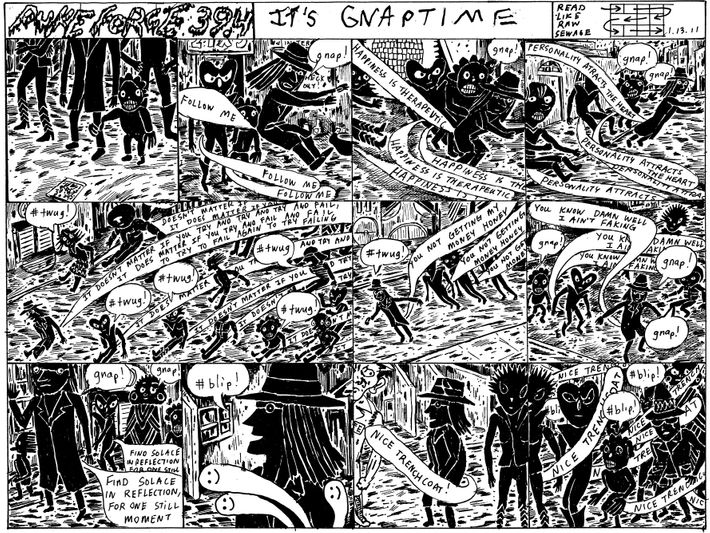
Forgive me for asking such a basic question, but how is making comics different from making music?
In the realm of doodling, its kind of similar because most song ideas for me, or for us, my band, comes from jamming. Its literally shutting your brain off and flinging your arms around. Theres a song inside of you, at least one every day, and if you have the time, you can get it out and document the rough origin of that thing, and that thing is probably a synthesis of some melody you heard, some experience you had, the way someone treated you. All that stuff synthesizes. We record everything  Its the same as having these sheets of doodles with a million ideas, most of which suck. Theres the physicality, at least in my part of it, to the drumming that isnt repeated by sitting at a desk, drawing. A lot of times me sitting at a desk drawing involves getting up and jumping around and getting excited or something, maybe dancing a little bit. You have to move a little bit when youre drawing.
How long does it take you to do one of the big, action-filled splash pages, like the big bar fight that happens about two-thirds of the way through the book?
It takes almost the same amount of time as the regular page, because the regular pages are actually comprised of the same amount of marks, theyÔÇÖre just more repetitive because itÔÇÖs the same characters in the same basic formation, but itÔÇÖs the same amount of marks. If I put in five hours a day or something, maybe one of the big ones would take three days, something like that.
Jesus Christ! 
Maybe. Maybe less. Maybe it was ten hours or something, 15 hours. TimeÔÇÖs so weird when youÔÇÖre drawing. Those big ones are penciled out in advance, too, so thereÔÇÖs also that. YouÔÇÖre drawing it twice, or youÔÇÖre drawing like half of it, and then youÔÇÖre re-drawing it.
The labor shows, and in a good way. A lot of comics that people make feel almost machinelike ÔÇö you canÔÇÖt necessarily envision the hand that drew them. But yours feel like theyÔÇÖre fresh off of your desk. I can visualize your sketching in the finished work.
Everything I do is very much self-centered, in a way. Everything I do is, I made this, and I labored over it. ThereÔÇÖs a human quality, and it couldnÔÇÖt be pumped out on a huge regular basis because of the amount of labor involved.
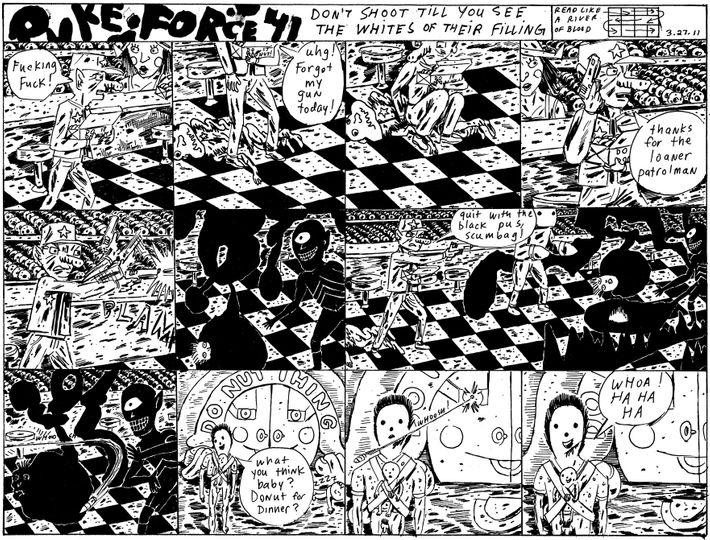
You use an unconventional reading order for your panels: The reader is supposed to move from left to right on the top row of panels, then from right to left for the next row, then back from left to right, and so on. Why do that?
I want it to look like an animation of sorts. I didnÔÇÖt want the reader to have to jump back to the left side of the page and start over, because thereÔÇÖs this moment of disconnect. If youÔÇÖre looking at a series of panels, they should never become unglued, they should always be touching. Your eyes will never leave this figure, and youÔÇÖll follow them through the pages. A lot of the time, that means when theyÔÇÖre going on a walk, theyÔÇÖre walking to the right for the first four panels, but then theyÔÇÖre walking to the left on the next ones because I like this forward-motion feeling. It was just this idea that there shouldnÔÇÖt be this suspension of movement while your eye flicks back to the left side of the page.
A lot of your characters are governed by fear. What scares you?
IÔÇÖm terrified that IÔÇÖll wake up the next day and nothing IÔÇÖve done ever in my life makes any more sense. I have to do it all now because tomorrow, who knows? IÔÇÖm going to look at this and realize what garbage it is, and IÔÇÖll never want to do it again. Humans are scary. Humans are the scariest thing there is. It is a weird world. Listening to this insane election cycle that weÔÇÖre in, itÔÇÖs constant fearmongering, at least from the GOP side. ItÔÇÖs insanity.
Then again, we were on tour in November in Europe, two days after the Paris bombings, and we rolled into France to play three shows. We didnÔÇÖt go to Paris, we were in other cities, but we played within an hour of Paris within a week. There were way more guns than IÔÇÖd ever seen at the borders. They didnÔÇÖt give us shit. We were fine, we were two Americans and a guy from Belgium, all very white, and we were quickly let in, and it was all fine for us. Here we are, playing music two days after this thing, and in another way, I actually felt safe. It was like, lightning doesnÔÇÖt strike twice in the same place. It wouldnÔÇÖt be very sneaky and terrorist of someone to blow up another music venue after blowing up a music venue.
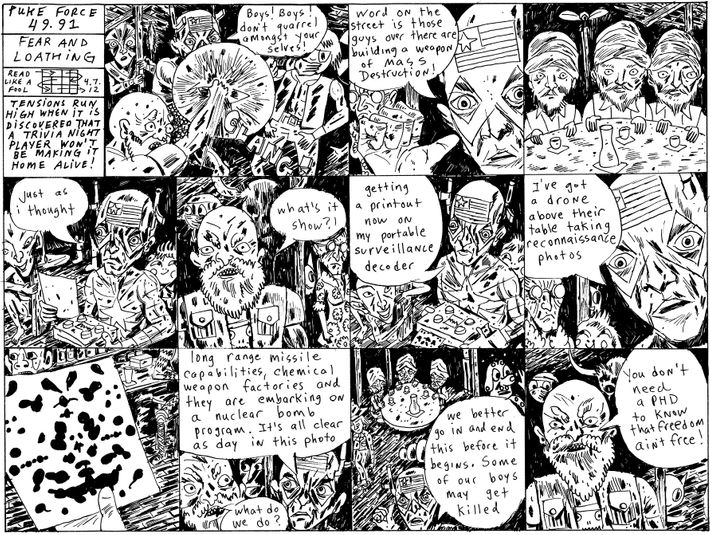
There are real things to fear out there, but the biggest thing to fear is people who arenÔÇÖt getting ÔÇö itÔÇÖs not just getting the information, but being able to process lots of information. ThereÔÇÖs things to fear out there, itÔÇÖs a scary world, but then you look at statistics, and violence is actually down, and itÔÇÖs just that people are so terrified in some small town in the United States that some terrorist is going to blow them up. Man, youÔÇÖre not going to get blown up by a terrorist, youÔÇÖre going to get hit by your neighbor whoÔÇÖs driving down the street and slides in the snow or whatever, or your friendÔÇÖs gun is going to go off in his own face. Terrorism is an issue, but itÔÇÖs not the issue. The issue we should be talking about is why might people be able to be convinced that we suck as a nation.
ThereÔÇÖs one character whoÔÇÖs definitely not governed by fear, and we meet him throughout the book: A.W. Dude. He walks around with no pants, heÔÇÖs prone to abrupt bodily functions, and he seems endlessly cheerful. What do you like about him?
His whole thing is, I think one of the worst looks for a guy is a guy that walks around with no pants. Theres some point when youre with a significant other, theyre like, Oh my God, thats the worst look ever, and you realize youre walking around with a shirt and no pants. He is, in a way, the most developed character in the book, and his persona is, he doesnt give a shit but he actually does. He saves a baby! My original idea for the book was that he was going to die and that was how the book was going to end. Who could I sacrifice that would make the most  Who could be sacrificed and go out in this crazy bang and be the saddest guy to die, and it would be A.W. Dude because hes the coolest guy, but I couldnt kill him. I like him too much. He isnt ruled by fear. Maybe its all about following him around and realizing that you can walk around with no pants and puke your way through life, with a baby strapped to you, and youll be all right.

